Comparative Analysis of Fire and Explosion Properties of Lycopodium Powder
Abstract
:1. Introduction
2. Materials and Methods
2.1. Materials
2.2. Methods
2.2.1. Moisture Content Analysis
- —sample mass before drying [g];
- —sample mass after drying [g].
2.2.2. Elemental Analysis
2.2.3. Particle Size Distribution Analysis
2.2.4. Minimum Ignition Temperature of Dust Layer
2.2.5. Minimum Ignition Temperature of Dust Cloud
2.2.6. Spontaneous Ignition Behavior
2.2.7. Explosion Characteristics of Dust Clouds
- —pressure created by the ignition heads [bar];
- —ignition energy [J].
3. Results and Discussion
3.1. Moisture Content Analysis
3.2. Elemental Analysis
3.3. Particle Size Distribution Analysis
3.4. Minimum Ignition Temperatures of Dust Layer and Dust Cloud
3.5. Spontaneous Ignition Behavior
- —volume of a cylinder [m3];
- —surface [m2].
3.6. Explosion Characteristics of Dust Clouds
| Data | Maximum Dust Explosion Pressure [bar] | Maximum Rate of Dust Explosion Pressure Rise [bar/s] | Dust Constant Kst [bar m/s] | Lower Explosion Limit [g/m3] | Reference |
|---|---|---|---|---|---|
| Experimental | 7.16 | 333.4 (250 g/m3) | 90.5 | 15 | - |
| The Literature | - | 225 (750 g/m3) | - | - | [37] |
| 6.5 | 283 (1000 g/m3) | 76.8 | - | [38] | |
| 7.3 | 470 (500 g/m3) | - | - | [39] | |
| 7.21 | 182.7 (250 g/m3) | 130.6 | - | [12] | |
| 6.3 | 381.2 (250 g/m3) | 103.5 | - | [40] | |
| - | - | 119 | <15 | [26] |
4. Conclusions
Author Contributions
Funding
Data Availability Statement
Conflicts of Interest
References
- Mundargi, R.C.; Potroz, M.G.; Park, S.; Park, J.H.; Shirahama, H.; Lee, J.H.; Seo, J.; Cho, N.-J. Lycopodium Spores: A Naturally Manufactured, Superrobust Biomaterial for Drug Delivery. Adv. Funct. Mater. 2016, 26, 487–497. [Google Scholar] [CrossRef]
- Kumar, P.; Jha, S.; Naved, T. Validated modified Lycopodium spore method development for standardisation of ingredients of an ayurvedic powdered formulation Shatavaryadi churna. Afr. J. Tradit. Complement. Altern. Med. 2013, 10, 426–430. [Google Scholar] [CrossRef] [PubMed]
- Spijker, C.; Raupenstrauch, H. Numerical investigation on inner particle effects in Lycopodium/Air dust deflagrations. J. Loss Prev. Process Ind. 2017, 49, 870–879. [Google Scholar] [CrossRef]
- Addo, A. Investigation of Marginal Explosibility of Organic Dusts in the 20 L and 1 m3 Explosion Chambers. Ph.D. Thesis, Dalhousie University, Halifax, NS, Canada, 2018. [Google Scholar]
- Łędzki, A.; Zieliński, K.; Klimczyk, A. Podstawy Technologii Wytwarzania i Przetwarzania. In Odlewnictwo; Akademia Górniczo-Hutnicza: Kraków, Poland, 2010. [Google Scholar]
- Referowska-Chodak, E. Leśne pożytki w kontekście prawnej ochrony lasów iglastych. Stud. I Mater. Cent. Edukac. Przyr.-Leśnej 2014, 16, 69–88. [Google Scholar]
- Bidabadi, M.; Mostafavi, S.A.; Beidaghy Dizaji, H.; Faraji Dizaji, F. Lycopodium Dust Flame Characteristics Considering Char Yield. Sci. Iran. 2013, 20, 1781–17918. [Google Scholar]
- Willey, R.J.; Shanley, E.S. A dust explosion apparatus suitable for use in lecture demonstrations. Chem. Eng. Educ. 2004, 38, 188–195. [Google Scholar]
- Janovsky, B.; Skrinsky, J.; Cupak, J.; Veres, J. Coal dust, Lycopodium and niacin used in hybrid mixtures with methane and hydrogen in 1 m3 and 20 l chambers. J. Loss Prev. Process Ind. 2019, 62, 103945. [Google Scholar] [CrossRef]
- Bernard, S.; Lebecki, K.; Gillard, P.; Youinou, L.; Baudry, G. Statistical method for the determination of the ignition energy of dust cloud-experimental validation. J. Loss Prev. Process Ind. 2010, 23, 404–411. [Google Scholar] [CrossRef]
- Bidabadi, M.; Beidaghy Dizaji, H.; Faraji Dizaji, F.; Mostafavi, S.A. A parametric study of lycopodium dust flame. J. Eng. Math. 2015, 92, 147–165. [Google Scholar] [CrossRef]
- Szabová, Z.; Kuracina, R.; Sahul, M.; Mynarz, M.; Lepík, P.; Kosár, L. Influence of the Pyrotechnic Igniter Composition Aging on Explosion Parameters of Dispersed Dusts. Appl. Sci. 2021, 11, 10728. [Google Scholar] [CrossRef]
- Kukfisz, B. Analysis of minimum ignition temperature of pellet dust layer and cloud due to adding BC and ABC fire extinguishing powders. In Proceedings of the Fire and Environmental Safety Engineering, Lviv, Ukraine, 7–8 November 2018; p. 9. [Google Scholar]
- EN 50281-2-1:1998; Electrical Apparatus for Use in the Presence of Combustible Dust—Part 2-1: Test Methods—Methods for Determining the Minimum Ignition Temperatures of Dust. iTeh Standards: Etobicoke, ON, Canada, 1998.
- EN 15188:2020; Determination of the Spontaneous Ignition Behaviour of Dust Accumulations. iTeh Standards: Etobicoke, ON, Canada, 2020.
- EN 14034-1:2004+A1:2011; Determination of Explosion Characteristics of Dust Clouds—Part 1: Determination of the Maximum Explosion Pressure Pmax of Dust Clouds. iTeh Standards: Etobicoke, ON, Canada, 2011.
- EN 14034-2:2006+A1:2011; Determination of Explosion Characteristics of Dust Clouds—Part 2: Determination of the Maximum Rate of Explosion Pressure Rise (dp/dt)Max of Dust Clouds. iTeh Standards: Etobicoke, ON, Canada, 2011.
- EN 14034-3:2006+A1:2011; Determination of Explosion Characteristics of Dust Clouds—Part 3: Determination of the Lower Explosion Limit LEL of Dust Clouds. iTeh Standards: Etobicoke, ON, Canada, 2011.
- Addo, A.; Dastidar, A.G.; Taveau, J.R.; Morrison, L.S.; Khan, F.I.; Amyotte, P.R. Niacin, lycopodium and polyethylene powder explosibility in 20-L and 1-m3 test chambers. J. Loss Prev. Process Ind. 2019, 62, 103937. [Google Scholar] [CrossRef]
- Amez, I.; Castells, B.; León, D.; García-Torrent, J.; Medic, L. Experimental study on inert products, moisture, and particle size effect on the minimum ignition energy of combustible dusts. J. Loss Prev. Process Ind. 2023, 81, 104968. [Google Scholar] [CrossRef]
- Adamski, R.; Siuta, D.; Kukfisz, B.; Mitkowski, P.T.; Szaferski, W. Influence of process parameters in superheated steam drying on fire and explosion parameters of woody biomass. Fuel Process. Technol. 2021, 211, 106597. [Google Scholar] [CrossRef]
- Yuan, J.; Wei, W.; Huang, W.; Du, B.; Liu, L.; Zhu, J. Experimental investigations on the roles of moisture in coal dust explosion. J. Taiwan Inst. Chem. Eng. 2014, 45, 2325–2333. [Google Scholar] [CrossRef]
- Mostafavi, S.A.; Salavati, S.; Dizaji, H.B.; Mehdi, B. Pyrolysis and combustion kinetics of lycopodium particles in thermogravimetric analysis. J. Cent. South Univ. 2015, 22, 3409–3417. [Google Scholar] [CrossRef]
- Addai, E. Investigation of Explosion Characteristics of Multiphase Fuel Mixtures with Air; Otto-vonGuericke-University of Magdeburg: Magdeburg, Germany, 2016. [Google Scholar]
- Renganathan, B.; Viswanathan, A.; Sastikumar, D.; Hameed, S.S. Measurement of Particle Size of Lycopodium Powder Using He-Ne Laser. In Proceedings of the Frontiers in Optics 2007/Laser Science XXIII/Organic Materials and Devices for Displays and Energy Conversion, San Jose, CA, USA, 16 September 2007. [Google Scholar]
- GESTIS-DUST-EX, Database Combustion and Explosion Characteristics of Dusts. Available online: http://staubex.ifa.dguv.de/explokomp.aspx?nr=1282&lang=e (accessed on 31 July 2023).
- Hosseinzadeh, S.; Vanierschot, M.; Norman, F.; Verplaetsen, F.; Berghmans, J. Flame propagation and flow field measurements in a Hartmann dust explosion tube. Powder Technol. 2018, 323, 346–356. [Google Scholar] [CrossRef]
- Porowski, R.; Bodalski, D.; Strzyżewska, M. Experimental Study and Digital Analysis of Flammable Dust Granularity. Bezp. I Tech. Pożar. 2014, 4, 77–84. [Google Scholar]
- Loubet, B.; Jarosz, N.; Saint-Jean, S.; Huber, L. A method for measuring the settling velocity distribution of large biotic particles. Aerobiologia 2007, 23, 159–169. [Google Scholar] [CrossRef]
- Chen, X.; Chen, D.; Cao, Z.; Zhao, L.; Bao, Y.; Zhuang, C.; Zhang, Y. Analysis of influencing factors on minimum ignition energy of Stevioside/Lycopodium dust cloud. J. Phys. Conf. Ser. 2021, 2021, 012096. [Google Scholar] [CrossRef]
- Ding, J.; Wang, X.; Chen, Y.; Salzano, E. The effects of phosphorus-free inhibitors on the ignition of lycopodium dust. J. Loss Prev. Process Ind. 2021, 72, 104543. [Google Scholar] [CrossRef]
- Park, H. Hot Surface Ignition Temperature of Dust Layers with and without Combustible Additives; Worcester Polytechnic Institute: Worcester, MA, USA, 2006. [Google Scholar]
- Eckhoff, R.K. Dust Explosions in the Process Industries; Elsevier Inc.: Amsterdam, The Netherlands, 2003; Volume 744. [Google Scholar] [CrossRef]
- Lunn, G.A.; Gummer, J. Mechanical ignition of dust accumulations and the ignition capabilities of smouldering nests. Inst. Chem. Eng. Symp. Ser. 2001, 148, 227–239. [Google Scholar]
- Dowbysz, A.; Kukfisz, B.; Samsonowicz, M.; Bihałowicz, J.S. Determination of the Self-Ignition Behavior of the Accumulation of Sludge Dust and Sludge Pellets from the Sewage Sludge Thermal Drying Station. Energies 2023, 6, 46. [Google Scholar] [CrossRef]
- Domański, W. Pyłowe atmosfery wybuchowe—Parametry charakteryzujące wybuchowość pyłów. Bezp. Pr. 2016, 7, 14–17. [Google Scholar] [CrossRef]
- Sanchirico, R.; Russo, P.; Di Sarli, V.; Di Benedetto, A. On the explosion and flammability behavior of mixtures of combustible dusts. Process Saf. Env. Prot. 2015, 94, 410–419. [Google Scholar] [CrossRef]
- Yan, X.; Yu, J. Dust explosion venting of small vessels at the elevated static activation overpressure. Powder Technol. 2014, 261, 250–256. [Google Scholar] [CrossRef]
- Porowski, R.; Małozięć, D. Zagrożenie wybuchem pyłów palnych oraz metody zapobiegania. Bezp. I Tech. Pożar. 2012, 4, 107–117. [Google Scholar]
- Ji, W.; Yu, J.; Yu, X.; Yan, X. Experimental investigation into the vented hybrid mixture explosions of lycopodium dust and methane. J. Loss Prev. Process Ind. 2018, 51, 102–111. [Google Scholar] [CrossRef]

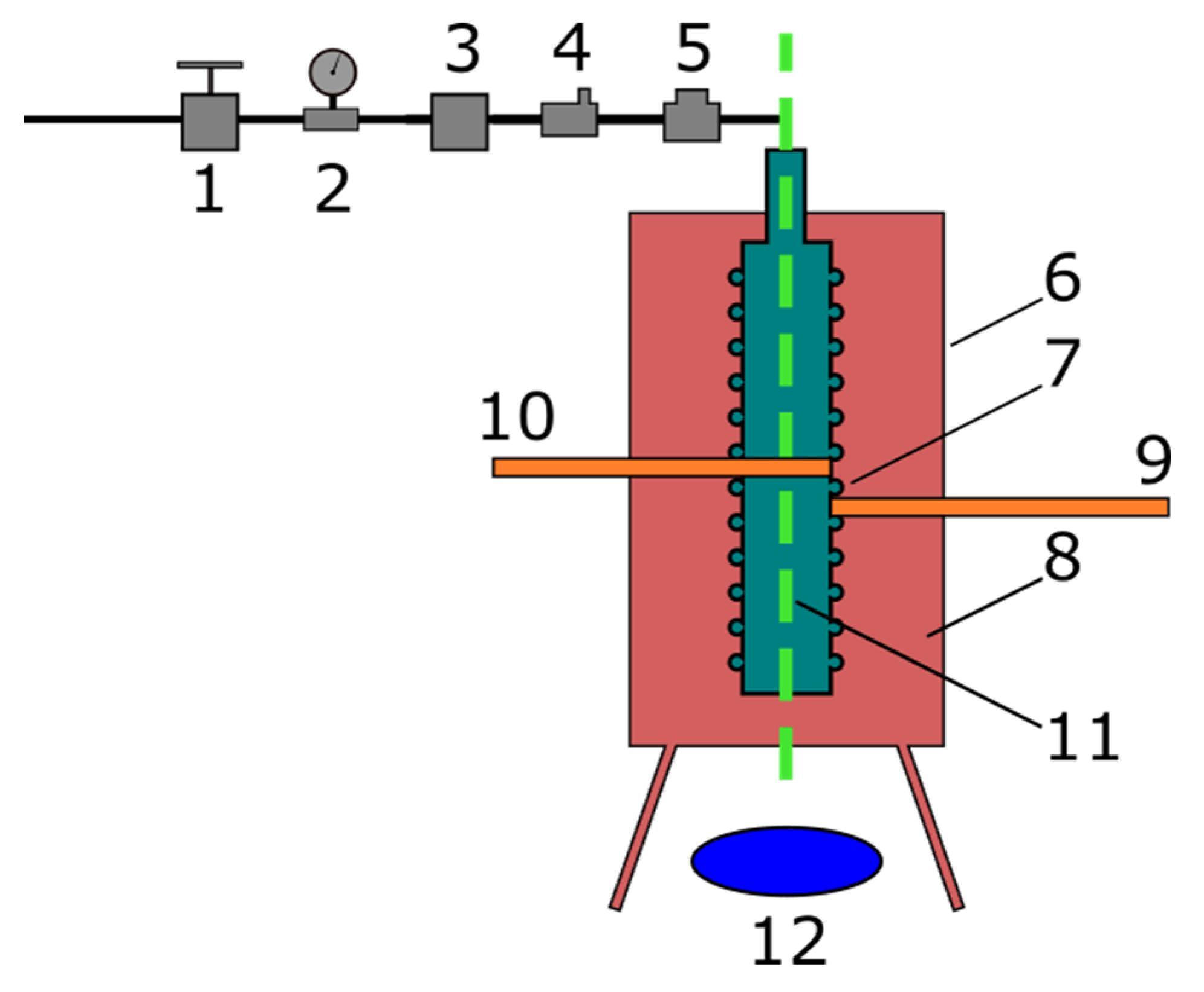
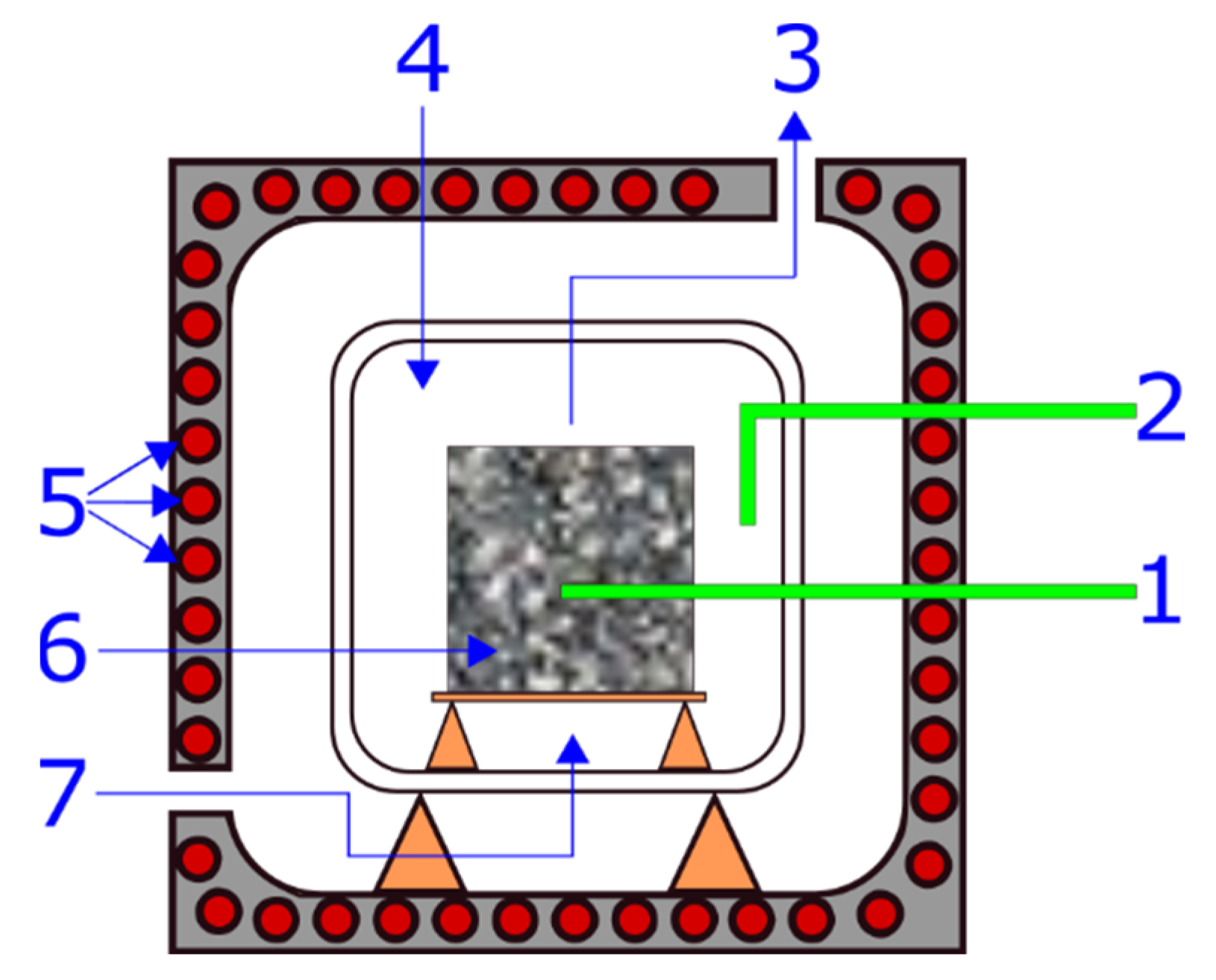
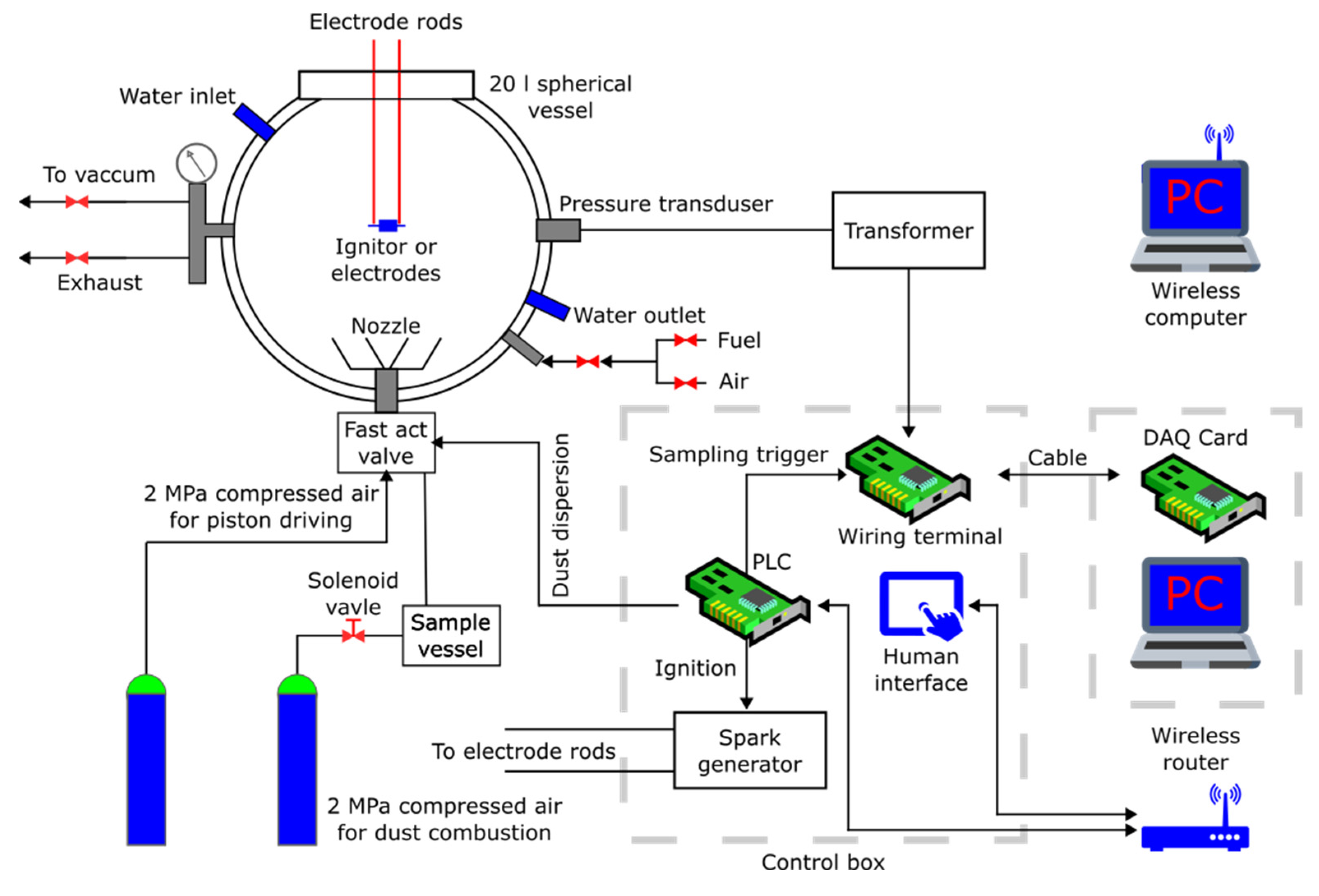
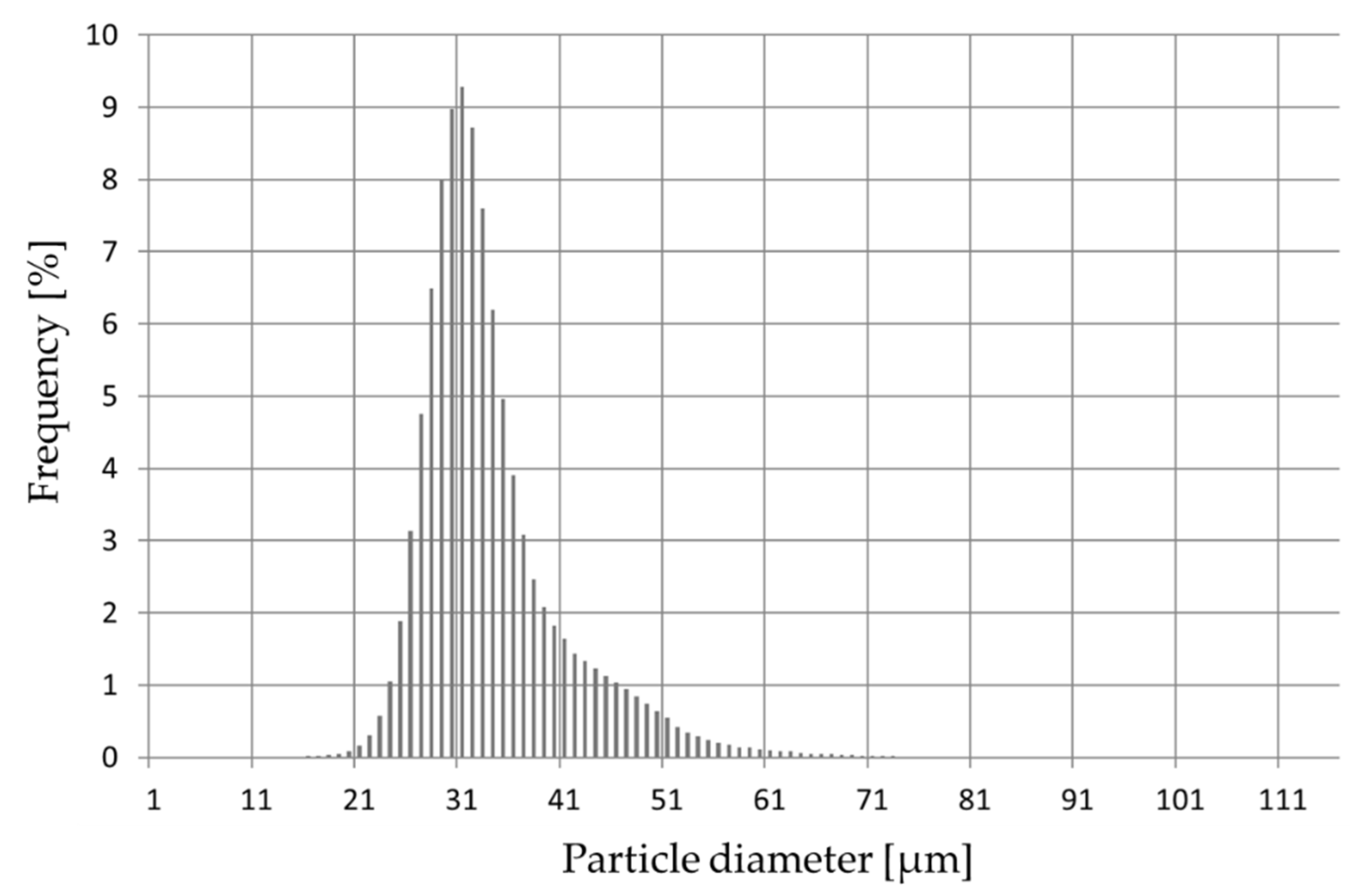
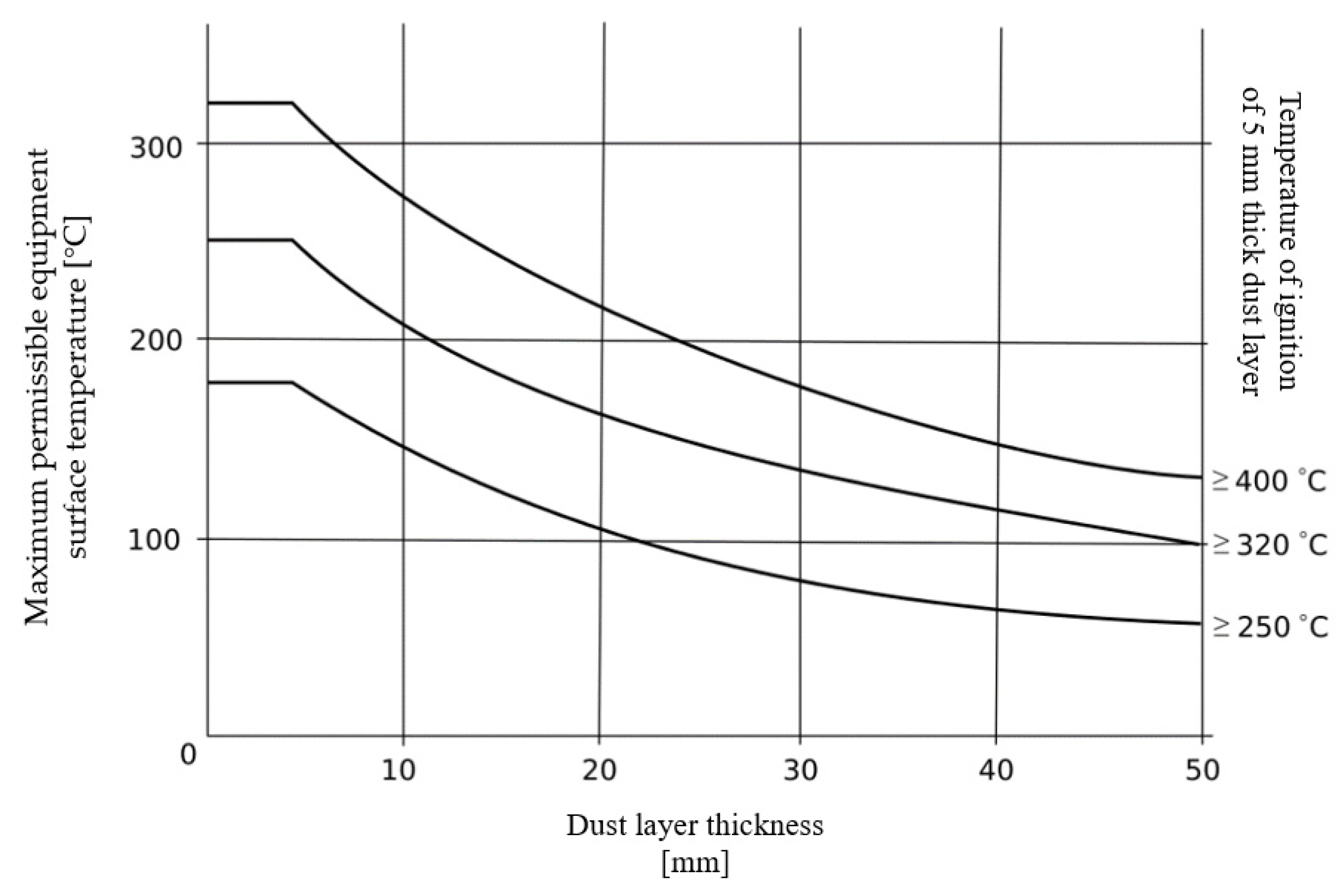
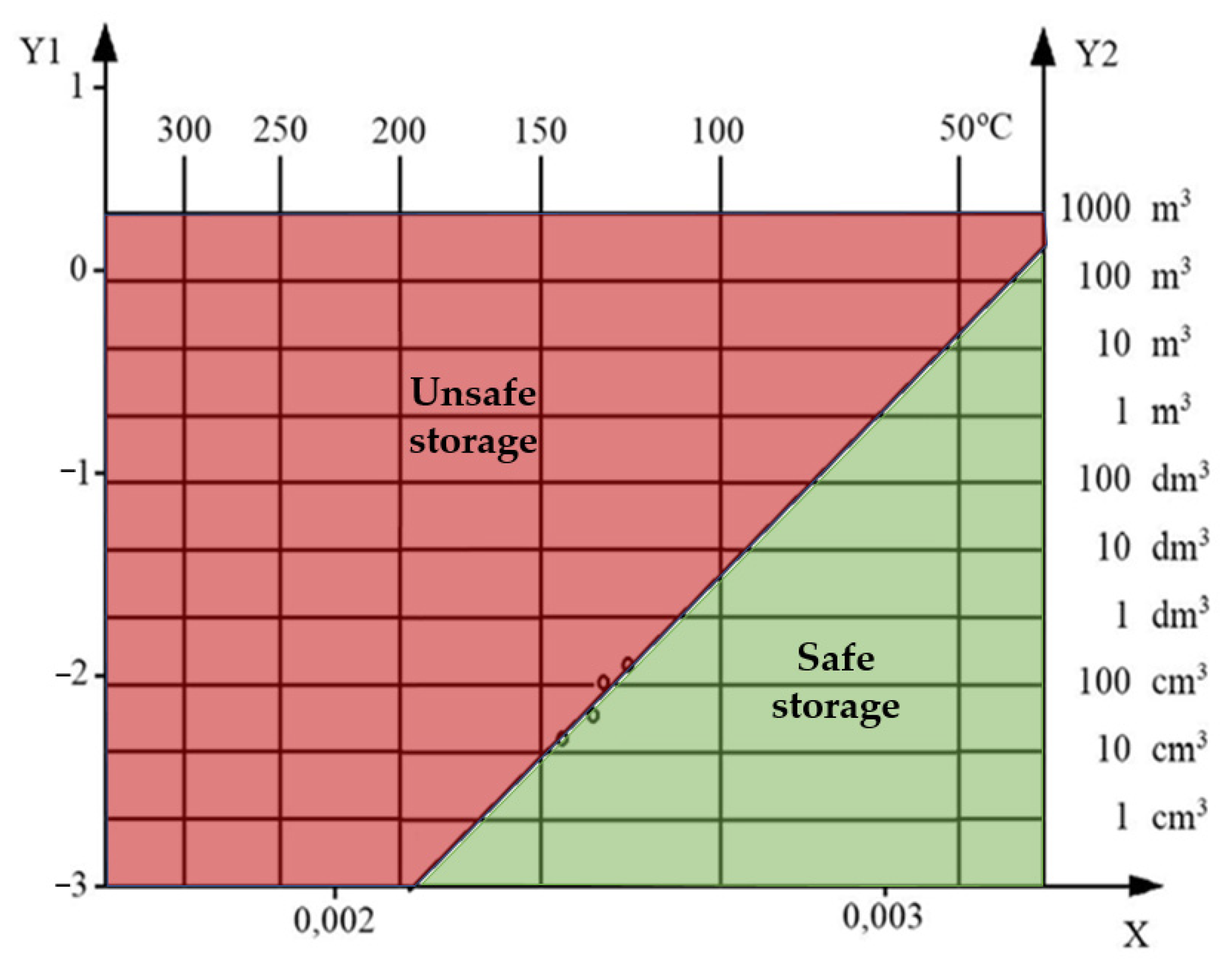
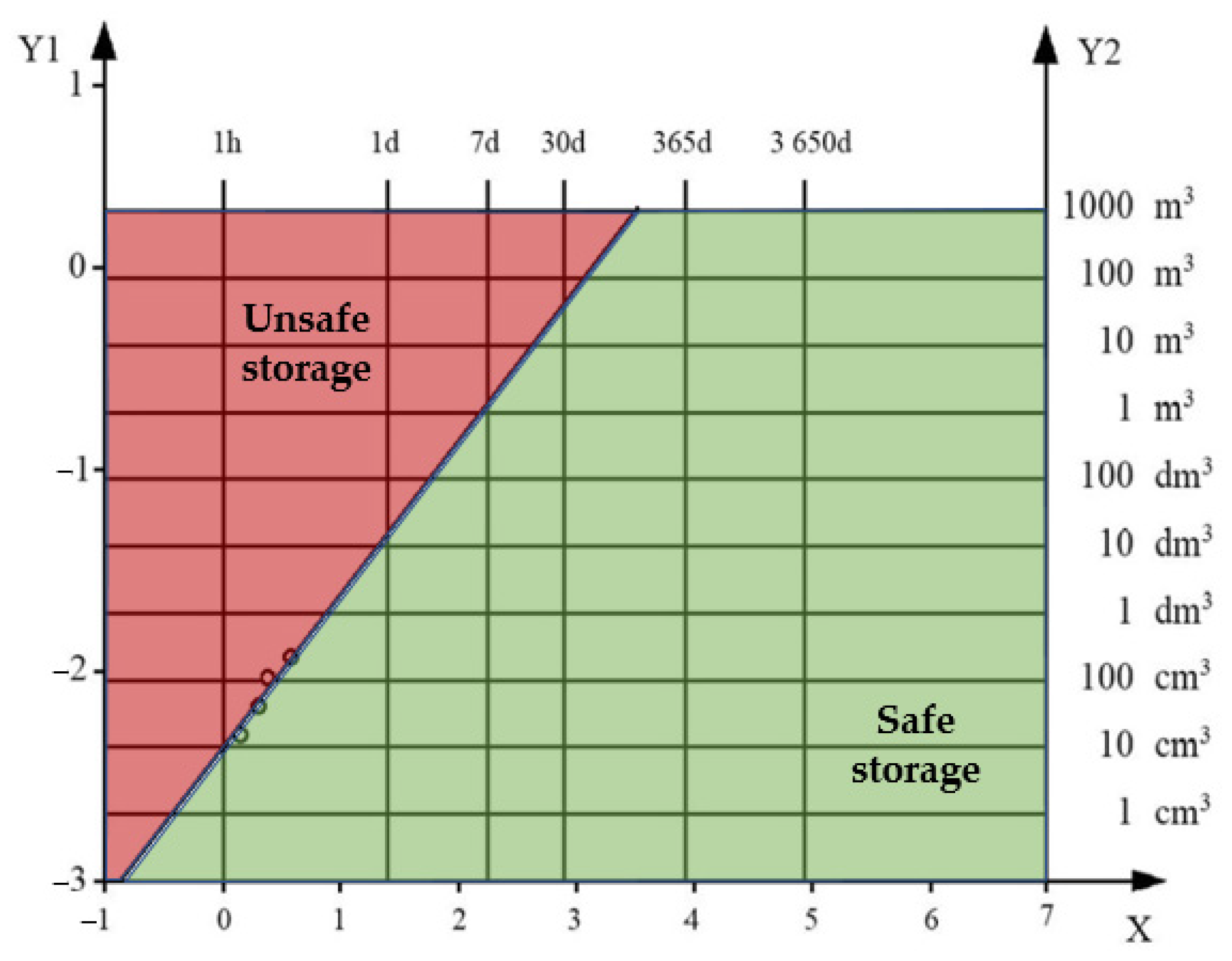
| Measurement | Drying Time [s] | Sample Mass before Drying [g] | Sample Mass after Drying [g] | Moisture Content [wt. %] |
|---|---|---|---|---|
| 1 | 250 | 2.001 | 1.942 | 2.878 ± 0.061 |
| 2 | 225 | 2.006 | 1.949 | |
| 3 | 215 | 2.004 | 1.947 |
| Element | Content [%] |
|---|---|
| Carbon | 60.1 |
| Hydrogen | 8.9 |
| Oxygen | 20.8 |
| Nitrogen | 2.1 |
| Sulphur | 0.1 |
| Measurement | Particles Quantity | Particles of Size <14 µm [%] | Particles of Size <36 µm [%] |
|---|---|---|---|
| 1 | 534,056 | 1 | 99 |
| 2 | 720,972 | 1 | 99 |
| 3 | 795,423 | 1 | 99 |
| Dust Layer Thickness [mm] | Time to Ignition [min] | Minimum Ignition Temperature of Dust Layer [°C] |
|---|---|---|
| 5 | 4 | 290 |
| 10 | 25 | 250 |
| 12.5 | 38 | 240 |
| 15 | 49 | 230 |
| 25 | 62 | 220 |
| 50 | 166 | 210 |
| Data | MITDL of Lycopodium of Thickness of 5 Mm [°C] | Reference | MITDC of Lycopodium [°C] | Reference |
|---|---|---|---|---|
| Experimental | 290 | 450 | ||
| The Literature | 260 | [31] | 426 | [31] |
| 283 | [32] | 430, 425 | [33] | |
| 460, 455 | ||||
| 420 | [19] | |||
| 410 | [26,34] |
| Sample Basket Volume [cm3] | Dust Weight [g] | Bulk Density [g/cm3] | Self-Ignition Temperature TSI [°C] |
|---|---|---|---|
| 23.00 | 6.984 | 0.304 | 146 |
| 54.80 | 16.121 | 0.294 | 136 |
| 105.15 | 32.349 | 0.308 | 134 |
| 207.39 | 62.152 | 0.300 | 128 |
Disclaimer/Publisher’s Note: The statements, opinions and data contained in all publications are solely those of the individual author(s) and contributor(s) and not of MDPI and/or the editor(s). MDPI and/or the editor(s) disclaim responsibility for any injury to people or property resulting from any ideas, methods, instructions or products referred to in the content. |
© 2023 by the authors. Licensee MDPI, Basel, Switzerland. This article is an open access article distributed under the terms and conditions of the Creative Commons Attribution (CC BY) license (https://creativecommons.org/licenses/by/4.0/).
Share and Cite
Kukfisz, B.; Dowbysz, A.; Samsonowicz, M.; Markowska, D.; Maranda, A. Comparative Analysis of Fire and Explosion Properties of Lycopodium Powder. Energies 2023, 16, 6121. https://doi.org/10.3390/en16176121
Kukfisz B, Dowbysz A, Samsonowicz M, Markowska D, Maranda A. Comparative Analysis of Fire and Explosion Properties of Lycopodium Powder. Energies. 2023; 16(17):6121. https://doi.org/10.3390/en16176121
Chicago/Turabian StyleKukfisz, Bożena, Adriana Dowbysz, Mariola Samsonowicz, Dorota Markowska, and Andrzej Maranda. 2023. "Comparative Analysis of Fire and Explosion Properties of Lycopodium Powder" Energies 16, no. 17: 6121. https://doi.org/10.3390/en16176121
APA StyleKukfisz, B., Dowbysz, A., Samsonowicz, M., Markowska, D., & Maranda, A. (2023). Comparative Analysis of Fire and Explosion Properties of Lycopodium Powder. Energies, 16(17), 6121. https://doi.org/10.3390/en16176121





